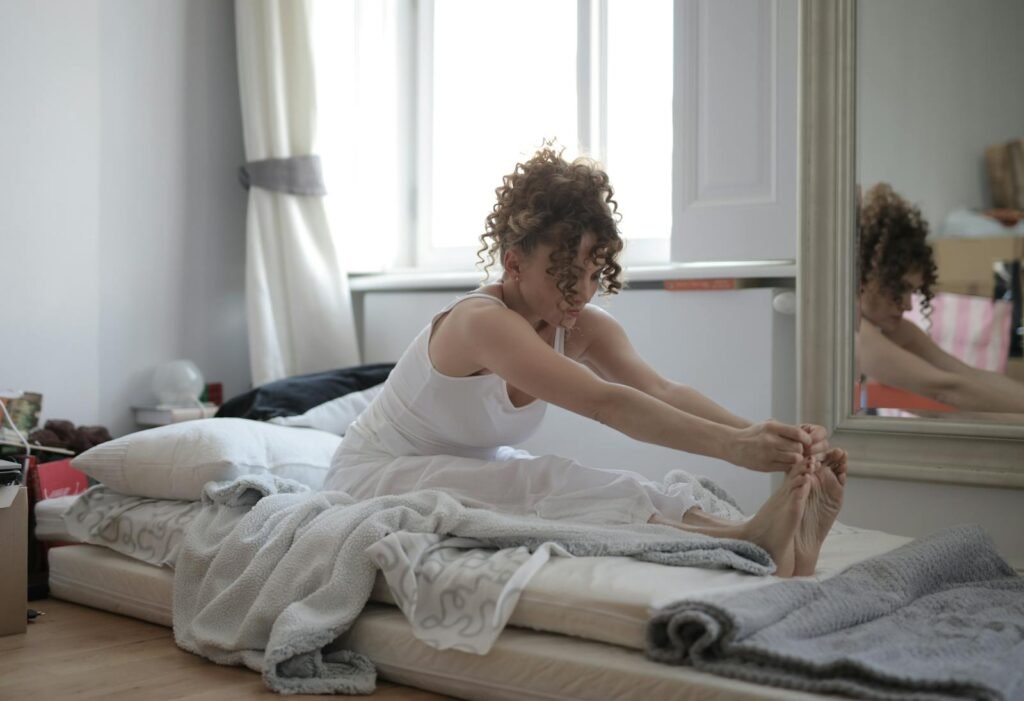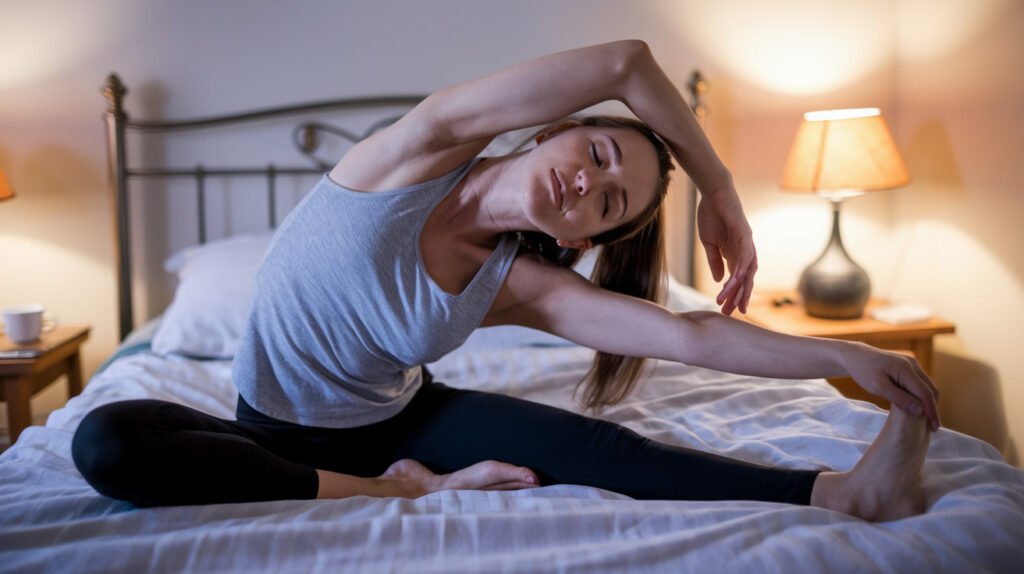As the day ends and the world quiets down, stretching becomes a key to better sleep. Imagine lying in bed, feeling relaxed and calm, as you fall asleep. A nightly stretching routine can greatly improve your physical and mental health.
Just a few minutes of stretching before bed can make a big difference. It can help you sleep better, feel more flexible, and calm. If you have neck or shoulder pain, or just want a good night’s sleep, stretching might be the answer.
Key Takeaways
- Stretching before bed can improve sleep duration and quality by relaxing muscles and reducing stress and body pain.
- Gentle stretches like yoga and tai chi have been shown to enhance sleep quality and promote better overall well-being.
- Incorporating 10 minutes of stretching into your wind-down routine can increase mobility, flexibility, and reduce the risk of injury.
- Stretching before bed can help alleviate common issues like neck, shoulder, and leg pain that may disrupt sleep.
- A consistent pre-bedtime stretching practice can contribute to better relaxation, muscle recovery, and overall sleep hygiene.
Understanding the Science Behind Nighttime Stretching
Adding stretching to your bedtime routine can greatly improve your sleep. Evening stretches help your body relax and prepare for sleep. They also boost your sleep hormones.
How Evening Stretches Affect Sleep Hormones
In the evening, your body starts making melatonin, the sleep hormone. Gentle stretches can make more melatonin. This helps your body relax and get ready for sleep.
The Role of Muscle Recovery During Sleep
Sleep is key for muscle repair. After a day of activity, muscles need rest to heal. Stretching before bed helps your muscles relax and recover better at night.
Impact on Nervous System Regulation
Stretching before bed also helps your nervous system. It moves your body from a stressed state to a relaxed one. This makes your body more ready for rest and improves sleep.
Research shows that yoga and tai chi, which include stretching, can better your sleep. Stretching is also good for older adults and women after menopause, helping them sleep better.
“Stretching before bed can have a profound impact on your sleep quality by positively influencing your sleep hormones, muscle recovery, and nervous system regulation.”
Benefits of stretching before bed Stretching before sleep Improve sleep
Adding flexibility exercises to your bedtime routine can greatly improve your sleep. Gentle stretches before bed help with better circulation, ease muscle tension, and aid in muscle recovery. These are key for a good night’s sleep.
Stretching before bed also helps prevent cramps at night. Muscles that are overused or strained can spasm if not relaxed. Just 10 minutes of gentle stretching can make a big difference in your comfort.
Stretching also boosts your flexibility and posture, leading to a sense of calm and well-being. Studies show that yoga and tai chi, which include gentle stretches, can greatly improve sleep quality.
The best time to stretch is 30 minutes to an hour before bed. This allows your body to relax fully. Remember, the goal is to stretch gently without causing pain.
| Stretching Benefits | Research Evidence |
|---|---|
| Improves sleep quality | A study found that exercises, including stretching, improved symptoms of insomnia when done for 60-minute sessions three times per week for 4 months. |
| Enhances flexibility and relaxation | Older adults experienced enhanced sleep quality through low-level physical and cognitive activity, with gentler stretching yielding better results than aerobics. |
| Prevents muscle cramps and spasms | In postmenopausal women with overweight, a study demonstrated that stretching may enhance sleep quality. |
By adding simple stretches to your bedtime routine, you can enjoy many benefits. These include flexibility exercises, better circulation, prevent cramps, and a more relaxing wind down practice before sleep.
Creating the Perfect Pre-Sleep Stretching Environment
Getting ready for a good night’s sleep begins with the right setting for stretching before bed. A cool room and soft, warm light help create a calm atmosphere. This setup is perfect for restorative yoga and eases muscle tension, stress and anxiety, and promotes relaxation.
Optimal Room Temperature and Lighting
The best temperature for stretching before bed is about 65°F (18°C). This cooler air tells your body it’s time to relax and get ready for sleep. Use soft, amber light that gets dimmer as you stretch. Stay away from bright lights, as they can stop your body from making melatonin, the sleep hormone.
Essential Equipment for Bedtime Stretching
- A comfortable, non-slip yoga mat for cushioning and grip
- Loose, breathable clothes for easy movement
- Pillows, blocks, or props for support in stretches
- A cozy blanket or towel to stay warm
Best Time to Start Your Routine
Start your stretching routine about 30 minutes to an hour before bed. This gives your body and mind time to relax from the day. It helps you stretch without feeling too tired.
Creating a calm, restorative yoga-like space helps you fully enjoy the stretch. You’ll feel the benefits of relieving muscle tension, reducing stress and anxiety, and promoting relaxation. Then, you can sleep well.
Essential Upper Body Stretches for Better Sleep
Adding upper body stretches to your bedtime routine can boost sleep quality. They help release tension in the neck, shoulders, and back. These stretches make your body more flexible, prevent muscle cramps, and help you relax.
The neck roll is a great stretch. Tilt your head to one side and feel the stretch in your neck. Roll your head forward, back, and to the other side a few times. This stretch can help decrease risk of injury and prevent muscle cramps in your neck.
The shoulder shrug is another good stretch. Lift your shoulders up to your ears, hold for a few seconds, and then lower them. This stretch improves flexibility in your shoulders and upper back, getting you ready for sleep.
| Stretch | Benefits |
|---|---|
| Bear Hug Stretch | Releases tension in the chest and shoulders, promoting relaxation. |
| Assisted Chest Stretch | Helps relieve stiffness in the pectorals and anterior deltoid muscles, serving as a natural sleep aid. |
Adding these upper body stretches to your evening routine can greatly improve your sleep. They enhance flexibility, prevent muscle cramps, and decrease the risk of injury. These simple movements can change your bedtime experience, making you feel refreshed and ready for the morning.
Lower Body Stretching Sequences for Relaxation
Adding lower body stretches to your bedtime routine can greatly improve sleep. It relaxes muscles and reduces stress. Focus on the hamstrings, calves, hips, and ankles to prepare for a good night’s sleep.
Hamstring and Calf Release Techniques
Begin with gentle stretches like the seated forward bend and standing calf stretch. These stretches target the hamstrings and calves. They help release tension and improve your relaxation before bed.
Hip Flexor Stretches for Tension Relief
Your hips and inner thighs are key for relaxation. Try the butterfly pose to stretch your hip flexors. This stretch helps with circulation and prepares you for sleep.
Ankle and Foot Mobility Exercises
Don’t overlook your feet and ankles. Simple exercises like ankle circles and toe taps prevent leg cramps. They also improve blood flow, helping you sleep better.
By adding these stretches to your bedtime routine, you’ll sleep better and feel less stressed. Always listen to your body and stretch at your own pace.
“Stretching before bed can be a game-changer for improving sleep quality and reducing stress. It’s all about finding the right sequence that works for your body.” – Yoga Instructor, Jane Guzman
Stress-Reducing Back and Spine Stretches
Adding gentle stretches to your bedtime routine can help reduce stress and improve sleep. These stretches target the back and spine. They ease muscle tension, boost circulation, and calm your body and mind before sleep.
The cat-cow pose is a great stretch. It eases tension in the neck, shoulders, and back. Start on your hands and knees. Arch your back and look up for the cow pose. Then, round your spine and tuck your chin for the cat pose. Repeat for a few minutes, focusing on your breath.
The child’s pose is another helpful stretch. It relaxes shoulder and facial muscles, bringing calm and quiet. Kneel on the bed, then sit back on your heels and fold forward. Extend your arms in front of you. Hold for 2-3 minutes, letting your body unwind.
- The spinal twist stretch targets the abs, chest, full back, and shoulders. Lie on your back, extend your arms out to the sides, and let your knees fall to one side. Turn your head to the opposite direction. Hold for 1-2 minutes, then repeat on the other side.
These stretches not only boost circulation but also prevent cramps. They are a calming practice before bed. Adding these stretches to your bedtime routine can ease you into a restful sleep.

Breathing Techniques to Enhance Your Stretching Practice
Adding breathing techniques to your restorative yoga and stretching can boost relaxation and sleep. Deep, rhythmic breathing helps gauge stretch intensity and promotes relaxation.
Diaphragmatic Breathing Methods
Diaphragmatic breathing, or belly breathing, involves slow, deep breaths that fill the belly. This method relieves muscle tension and reduces stress and anxiety. It activates the parasympathetic nervous system. Try it with stretches to enhance calmness.
Coordinating Breath with Movement
Linking breath with movement, like in yoga and tai chi, boosts relaxation. Breathe in while stretching, then breathe out as you relax. Hold each stretch for six to ten deep breaths for best relaxation.
“Mindful meditation practices incorporating gentle stretching, like yoga, have been found to improve sleep quality, physical performance, and relieve depression.”
Using these breathing methods before bed can ease into a peaceful night. It lets your body and mind relax fully.
Common Mistakes to Avoid During Evening Stretches
Adding stretching to your evening routine can boost flexibility, prevent muscle cramps, and lower injury risk. It also helps you sleep better naturally. But, it’s important to avoid mistakes that can ruin these benefits.
One big mistake is overstretching. Trying to stretch too far can hurt you and mess up your sleep. Instead, do gentle stretches that slowly relax your muscles without straining.
Also, don’t do hard exercises or intense workouts right before bed. These can wake you up and make it hard to fall asleep. Choose calming stretches that help you relax.
- Stop stretching if it hurts. Pushing through pain can make things worse and hurt more.
- Don’t hold your breath while stretching. Holding your breath can make you tense and ruin the relaxing effect of stretching.
- Focus on gentle stretches. Don’t try to stretch too far, as this can make you feel tense and awake instead of relaxed.
By avoiding these common mistakes, you can get the most out of your evening stretches. Listen to your body, stretch right, and use calming breathing. This will help you sleep better and feel refreshed.

| Stretching Recommendation | Duration |
|---|---|
| The American College of Sports Medicine recommends stretching each major muscle group | at least two times a week for 60 seconds per exercise |
| Static stretching (holding for 15 to 30 seconds) | considered a static stretch |
| Dynamic stretching (brisk walking, leg swings, or high stepping) | recommended for warming up before exercise |
| Stretching after exercise | helps to increase flexibility due to heightened circulation in the muscles and joints |
| Appropriate duration for effective stretching | about 30 seconds, according to research |
By following these tips and avoiding common mistakes, you can fully enjoy the benefits of evening stretches. You’ll sleep better and wake up feeling refreshed.
Progressive Relaxation Through Gentle Movement
As you end your evening stretching, think about adding progressive relaxation. This method can improve sleep quality, relax muscles, and reduce stress before bed.
Mind-Body Connection Techniques
Pay attention to each muscle group as you stretch. Tense the muscle, hold for a few seconds, then release it. This helps relax almost all major muscles, starting from the feet up or down.
- Start with big muscle groups like legs, stomach, chest, arms, shoulders, neck, and face for quick relaxation.
- Once you get the hang of it, try a release-only method for a smoother relaxation.
Transitioning from Stretching to Sleep
Finish your bedtime routine with savasana (corpse pose). This pose helps your body absorb the stretch benefits and gets you ready for sleep. Spend at least 15 minutes in this pose, focusing on your breath and letting go of tension.
“The key to a good night’s sleep is understanding the mind-body connection and using gentle movement to induce a state of deep relaxation.” – Dr. Sarah Johnson, Sleep Medicine Specialist
Adding progressive relaxation to your bedtime routine boosts your stretches’ benefits. Aim for 10-12 minutes each night for the best results.
Conclusion
Adding a nighttime stretching routine can change your sleep and health for the better. It helps you sleep well, feel less stressed, and move more easily. This simple habit can make a big difference in your life.
Choose stretches that work for your body, whether it’s your upper, lower, or back. Make a routine that feels right for you. By doing this, you can relax and recover better before sleep.
Improving your sleep with stretching is a personal journey. Pay attention to how your body feels and try new things. Gentle, mindful movements can help you sleep better. Enjoy the benefits of stretching before bed, stretching before sleep, and improve sleep with stretching in your nighttime stretching routine.




